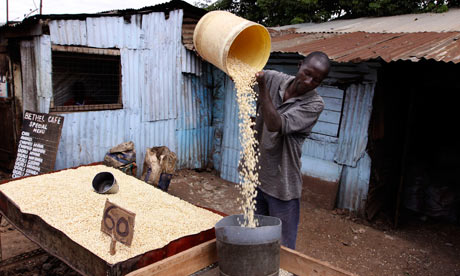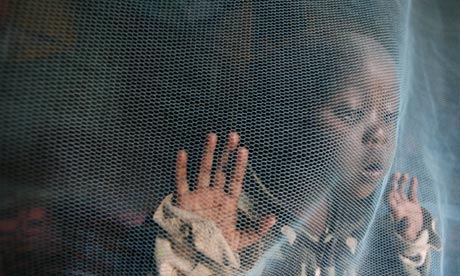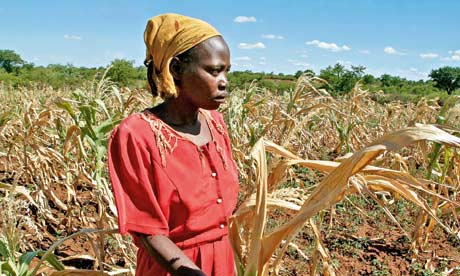Felicity Lawrence guardian.co.uk, 25 April 2011
 Selling maize in Nairobi, Kenya. Food prices around the world have risen to record levels in recent months, with campaigners blaming commodity traders for adding to the pressure. Photograph: Khalil Senosi/AP
Selling maize in Nairobi, Kenya. Food prices around the world have risen to record levels in recent months, with campaigners blaming commodity traders for adding to the pressure. Photograph: Khalil Senosi/AP
Barclays will be targeted during its annual meeting on Wednesday by anti-poverty campaigners accusing it of playing a leading role in driving up food prices on global commodities markets.
Barclays Capital, the investment banking arm of the high street bank, is the UK's biggest player in food commodity trading, and one of the top three banking players globally, according to a new analysis for the World Development Movement.
Along with Goldman Sachs and Morgan Stanley, BarCap has pioneered new kinds of financial products that have enabled pension funds and other investors traditionally barred from commodities exchanges to bet on food prices.
Deborah Doane, director of the World Development Movement (WDM), accused Barclays of making excessive profits at the expense of millions in poor countries. "First, it was sub-prime mortgages, now it's food commodities," she said. "The lack of transparency in these markets bears worrying resemblance to the behaviour that led to the 2008 financial crash. Like any irrational asset bubble, the investors pile their money in for short-term profits, in spite of the consequences."
The WDM report estimates that BarCap may have made as much as £340m in 2010 from its activities in food speculation. Precise figures are not known because much of the speculation takes the form of over-the-counter derivatives – trades entered privately between banks and clients. Banks do not publish a breakdown of revenues within divisions, so the WDM figure for Barclays is extrapolated from other measures published by the company, such as money at risk.
Barclays declined to comment in detail on the WDM report but said in a statement: "Barclays Capital conducts a variety of investment banking activities to help our clients across asset classes and geographies." It added that it acted as "an intermediary for our clients globally" rather than trading on its own behalf.
Barclays has already found its business ethics questioned this year, with UK Uncut, the campaign group, targeting branches over its tax avoidance activities. Soaring food prices have further highlighted the role of investment banks and hedge funds in commodity price spikes. The UN Food and Agriculture Organisation's (FAO's) food price index has reached record levels in recent months, and steep rises in the price of staples helped trigger the revolutions in Tunisia and Egypt.
While a range of factors, from climate change to demand for biofuels, have contributed to food price rises, financial speculation in agricultural commodity derivatives is believed by many, including the FAO, to have magnified volatility. Others, including the banks and the OECD, argue speculation is not a significant factor.
Financial activity in the commodities markets has seen explosive growth in the last few years. According to data from the UN special rapporteur on the right to food, Olivier De Schutter, investment in commodity index funds rose from $13bn (£7.9bn) in 2003 to $317bn by 2008. While there are no definitive figures on how those index funds break down, it is estimated that their holdings in agricultural commodity markets rose from about $3bn to over $55bn over that period.
Producers and processors of physical goods have long used commodities exchanges to hedge against risks such as bad harvests. But much of the recent growth has been through new "structured" products invented by banks and sold to investors.
After intense lobbying, banks won deregulation of commodities markets in the US in 2000, allowing them to develop these new products. Goldman Sachs pioneered commodity index funds which offer investors a chance to track changes in a spread of commodity prices. Barclays, meanwhile, invented "collateralised commodity obligations" in 2004, which resemble the synthetic collateralised debt obligations (CDOs) of credit crisis notoriety, except that they are backed by commodity trigger swaps instead o f credit default swaps. BarCap also has a leading position in commodity index investments.
There has been concern that the commodities boom represents a new risk to financial stability. The global financial watchdog, the Financial Stability Board, has warned that it has all the hallmarks of a bubble waiting to burst.
Michael Masters, the hedge fund manager who gave testimony to the US Senate on speculation and food prices in 2008, agrees that the growth is potentially dangerous. "Financial speculation now accounts for more than two thirds of the market, and only about 30% is physical hedgers," he said. "The percentages have flipped in that period. When billions of dollars of capital is being put to work in small markets like this, it amplifies price rises and if financial flows amplify prices of food stuffs and energy, it's not like real estate and stocks – when food prices double, people starve."
http://www.guardian.co.uk/business/2011/apr/25/barclays-faces-commodity-protests
 Selling maize in Nairobi, Kenya. Food prices around the world have risen to record levels in recent months, with campaigners blaming commodity traders for adding to the pressure. Photograph: Khalil Senosi/AP
Selling maize in Nairobi, Kenya. Food prices around the world have risen to record levels in recent months, with campaigners blaming commodity traders for adding to the pressure. Photograph: Khalil Senosi/APBarclays will be targeted during its annual meeting on Wednesday by anti-poverty campaigners accusing it of playing a leading role in driving up food prices on global commodities markets.
Barclays Capital, the investment banking arm of the high street bank, is the UK's biggest player in food commodity trading, and one of the top three banking players globally, according to a new analysis for the World Development Movement.
Along with Goldman Sachs and Morgan Stanley, BarCap has pioneered new kinds of financial products that have enabled pension funds and other investors traditionally barred from commodities exchanges to bet on food prices.
Deborah Doane, director of the World Development Movement (WDM), accused Barclays of making excessive profits at the expense of millions in poor countries. "First, it was sub-prime mortgages, now it's food commodities," she said. "The lack of transparency in these markets bears worrying resemblance to the behaviour that led to the 2008 financial crash. Like any irrational asset bubble, the investors pile their money in for short-term profits, in spite of the consequences."
The WDM report estimates that BarCap may have made as much as £340m in 2010 from its activities in food speculation. Precise figures are not known because much of the speculation takes the form of over-the-counter derivatives – trades entered privately between banks and clients. Banks do not publish a breakdown of revenues within divisions, so the WDM figure for Barclays is extrapolated from other measures published by the company, such as money at risk.
Barclays declined to comment in detail on the WDM report but said in a statement: "Barclays Capital conducts a variety of investment banking activities to help our clients across asset classes and geographies." It added that it acted as "an intermediary for our clients globally" rather than trading on its own behalf.
Barclays has already found its business ethics questioned this year, with UK Uncut, the campaign group, targeting branches over its tax avoidance activities. Soaring food prices have further highlighted the role of investment banks and hedge funds in commodity price spikes. The UN Food and Agriculture Organisation's (FAO's) food price index has reached record levels in recent months, and steep rises in the price of staples helped trigger the revolutions in Tunisia and Egypt.
While a range of factors, from climate change to demand for biofuels, have contributed to food price rises, financial speculation in agricultural commodity derivatives is believed by many, including the FAO, to have magnified volatility. Others, including the banks and the OECD, argue speculation is not a significant factor.
Financial activity in the commodities markets has seen explosive growth in the last few years. According to data from the UN special rapporteur on the right to food, Olivier De Schutter, investment in commodity index funds rose from $13bn (£7.9bn) in 2003 to $317bn by 2008. While there are no definitive figures on how those index funds break down, it is estimated that their holdings in agricultural commodity markets rose from about $3bn to over $55bn over that period.
Producers and processors of physical goods have long used commodities exchanges to hedge against risks such as bad harvests. But much of the recent growth has been through new "structured" products invented by banks and sold to investors.
After intense lobbying, banks won deregulation of commodities markets in the US in 2000, allowing them to develop these new products. Goldman Sachs pioneered commodity index funds which offer investors a chance to track changes in a spread of commodity prices. Barclays, meanwhile, invented "collateralised commodity obligations" in 2004, which resemble the synthetic collateralised debt obligations (CDOs) of credit crisis notoriety, except that they are backed by commodity trigger swaps instead o f credit default swaps. BarCap also has a leading position in commodity index investments.
There has been concern that the commodities boom represents a new risk to financial stability. The global financial watchdog, the Financial Stability Board, has warned that it has all the hallmarks of a bubble waiting to burst.
Michael Masters, the hedge fund manager who gave testimony to the US Senate on speculation and food prices in 2008, agrees that the growth is potentially dangerous. "Financial speculation now accounts for more than two thirds of the market, and only about 30% is physical hedgers," he said. "The percentages have flipped in that period. When billions of dollars of capital is being put to work in small markets like this, it amplifies price rises and if financial flows amplify prices of food stuffs and energy, it's not like real estate and stocks – when food prices double, people starve."
http://www.guardian.co.uk/business/2011/apr/25/barclays-faces-commodity-protests
 A Kenyan child plays under an insecticide treated mosquito net. Photograph: Stephen Morrison/EPA
A Kenyan child plays under an insecticide treated mosquito net. Photograph: Stephen Morrison/EPA
 Photo: David Gough/IRIN
Photo: David Gough/IRIN 
 “A linen shirt … is, strictly speaking, not a necessary of life. The Greeks and Romans lived, I suppose, very comfortably though they had no linen. But in the present times, through the greater part of Europe, a creditable day-labourer would be ashamed to appear in public without a linen shirt, the want of which would be supposed to denote that disgraceful degree of poverty which, it is presumed, nobody can well fall into without extreme bad conduct.”
“A linen shirt … is, strictly speaking, not a necessary of life. The Greeks and Romans lived, I suppose, very comfortably though they had no linen. But in the present times, through the greater part of Europe, a creditable day-labourer would be ashamed to appear in public without a linen shirt, the want of which would be supposed to denote that disgraceful degree of poverty which, it is presumed, nobody can well fall into without extreme bad conduct.”
 Ecowas secretariat in Abuja. The 15 member Economic Community of West African States, ranked among the poorest countries in the world has launched a regional programme to eradicate poverty. Photo/courtesy ECOWAS
Ecowas secretariat in Abuja. The 15 member Economic Community of West African States, ranked among the poorest countries in the world has launched a regional programme to eradicate poverty. Photo/courtesy ECOWAS  Farmer Loyce Nkala stands among her drought-devastated maize crop in Filabusi, south-west Zimbabwe. Photograph: Howard Burditt/Reuters/Corbis
Farmer Loyce Nkala stands among her drought-devastated maize crop in Filabusi, south-west Zimbabwe. Photograph: Howard Burditt/Reuters/Corbis












